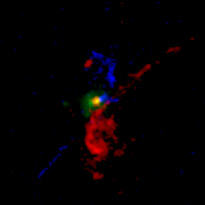The First Results from the KaVA Large Program for Star-formation Studies: Unveiling massive baby stars ejecting complex high velocity outflows

KaVA and ALMA observations have revealed a complex structure of a high-mass star-forming region, suggesting a formation scenario similar to those of Solar-type low-mass stars. This is the first result from one of the KaVA large programs, “Understanding high-mass star formation through KaVA observations of water and methanol masers” under collaboration between VERA and KaVA led by Mizusawa-VLBI Observatory of NAOJ and KASI (Korea Astronomy and Space Science Institute), respectively.
A star having a mass of more than 8 times the Sun is called as high-mass star. Observational studies on newly-born high-mass stars (protostars) provide important clues for understanding of their formation mechanisms. However, high-mass protostars are rare compared with low-mass Solar-type stars and they are usually located in far distant star clusters. Therefore, observational studies are challenging given the required high sensitivity and resolution. Until now, there still remains many unresolved questions about high-mass star-formation. These questions are also essential for understanding of formation of stars and planets, and evolution of galaxies because high-mass stars have significant impact on these processes by their strong radiation and production of heavy elements by supernova explosion.
KaVA (KVN and VERA Array) is an international VLBI network consisted of VERA (VLBI Exploration of Radio Astrometry) operated by NAOJ and KVN (Korean VLBI Network) operated by KASI.
One of the KaVA large programs, “Understanding high-mass star formation through KaVA observations of water and methanol masers” is conducting systematic observational studies aiming to address key questions on high-mass star-formation: “how high-mass stars collect their large amount of mass from their surrounding media?” and “how high-mass protostars drive high-velocity outflows and form surrounding circumstellar rotating disks as predicted by star-formation theories?”
From the ALMA data, a high-mass protostar G25.82-W1 newly formed in the G25.82-0.17 region is found to have a mass of at least 25 times that of the Sun. In addition, there are high density cores at an evolutionary stage prior to the onset of star-formation in this region, implying that it is a forming high-mass star cluster. G25.82-W1 is driving a high-velocity outflow at 50 km/s and is associated with a rotating gas. The system shows that a high-mass star in G25.82-0.17 is forming in a mechanism similar to those of Solar-type low-mass stars.
By using KaVA, a group of strong radio emission (water masers) is detected at the base of the outflow very close to the high-mass protostar G25.82-W1. Further data analysis will give us a hint for understanding of the driving mechanism of the outflow, which is one of the biggest questions in star-formation processes.
The present study is an important result demonstrating a potential of the KaVA large program to investigate detailed processes of high-mass star-formation. In the near future, it will be extended to a larger international collaboration through the East-Asian VLBI Network (EAVN).
The present results entitled “Multiple Outflows in the High-mass Cluster-forming Region G25.82–0.17” were published in The Astrophysical Journal, vol 896, id 127, 2020 June 20 issue.
Information Source:
The First Results from the KaVA Large Program for Star-formation Studies: Unveiling massive baby stars ejecting complex high velocity outflow
Original Paper:
“Multiple Outflows in the High-mass Cluster-forming Region G25.82-0.17”
Related WEB Sites:
- KaVA / KVN and VERA Array
- VERA / VLBI Exploration of Radio Astrometry
- KVN / Korean VLBI Network
- EAVN / East Asia VLBI Network
- ALMA
Other institutions:
- The Graduate University for Advanced Studies, SOKENDAI
- The Graduate University for Advanced Studies, SOKENDAI(English)
- National Astronomical Research Institute of Thailand
- National Astronomical Research Institute of Thailand(English)
- Shanghai Astronomical Observatory, Chinese Academy of Sciences
CSS not active
JavaScript not active

